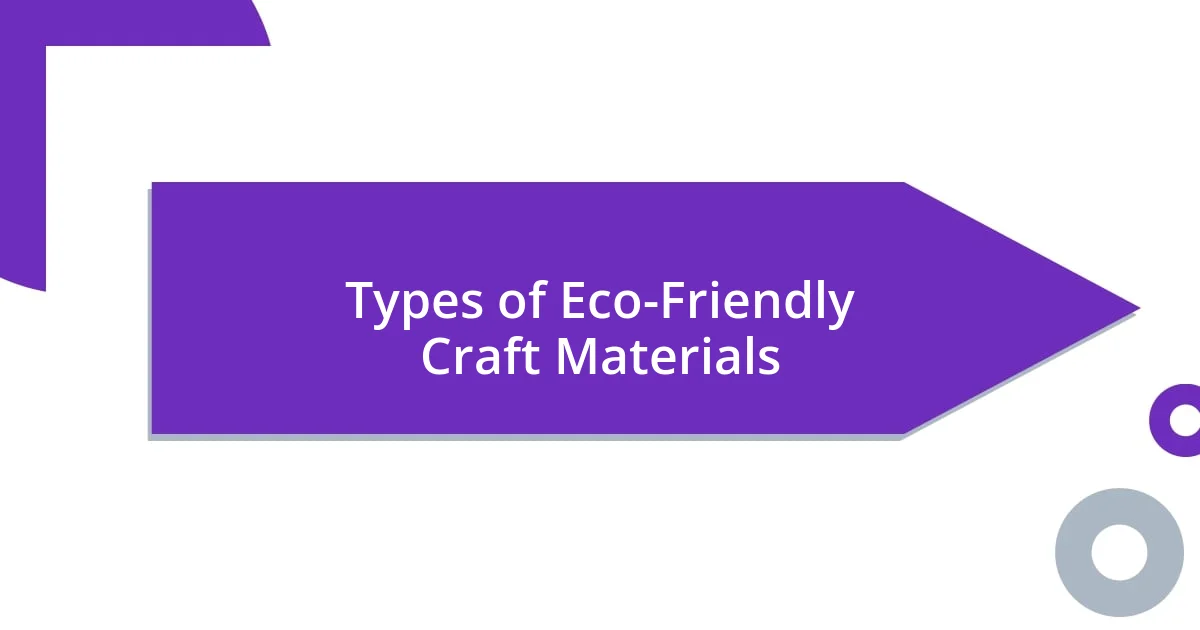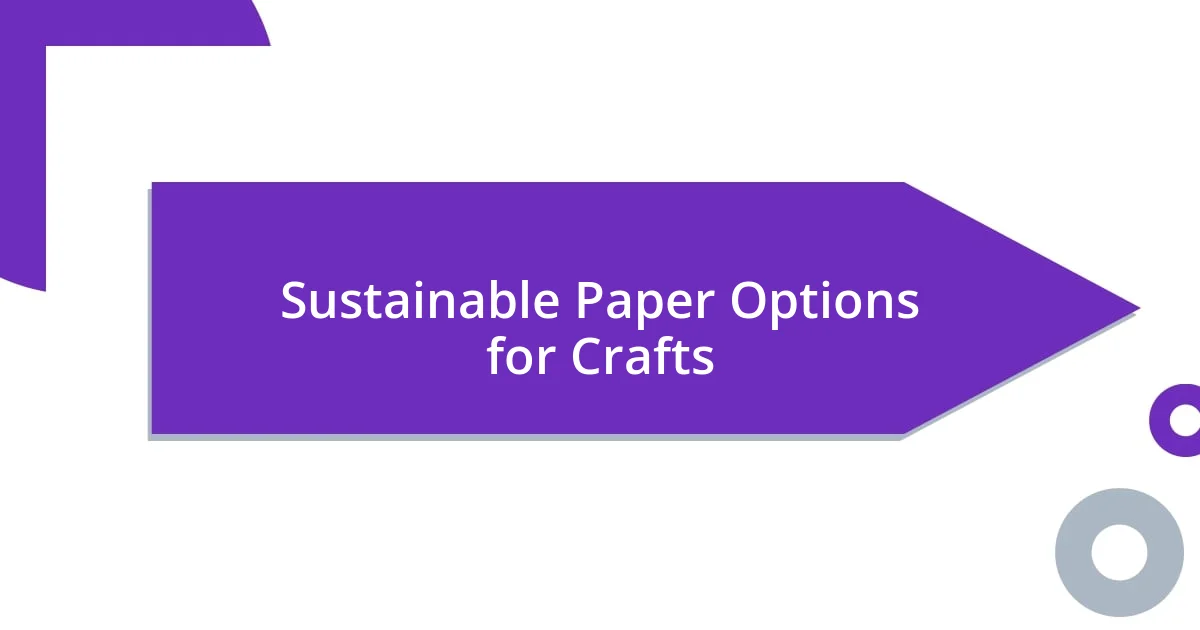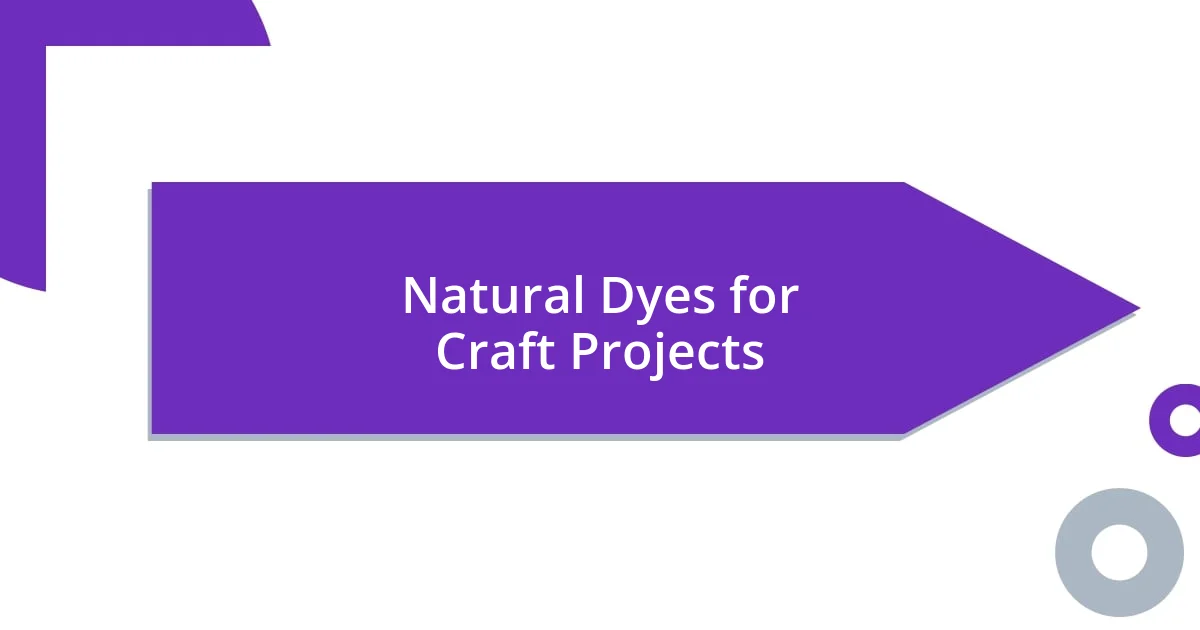Key takeaways:
- Embracing eco-friendly materials allows crafters to create unique art while promoting sustainability and reducing waste.
- Various types of eco-friendly materials include recycled paper, natural fibers, and plant-based resources, each adding unique qualities to crafts.
- Sourcing eco-friendly materials can be accomplished through local markets, relationships with artisans, and online sustainable marketplaces, enhancing creativity and supporting the community.

Introduction to Eco-Friendly Materials
Eco-friendly materials are an inspiring alternative to traditional crafting supplies, offering a way for crafters to express creativity while respecting the environment. When I first discovered the variety of sustainable options out there, I felt a surge of excitement—imagine creating something beautiful and knowing you’re being kind to the planet at the same time! It made me wonder: why wouldn’t everyone choose eco-friendly materials when they’re not just good for the Earth but also often more unique and inspiring?
As I began exploring these materials, I was struck by the sheer diversity they offer. From recycled paper to organic cotton, each option tells a story of sustainability and creativity. I remember making a scrapbook with biodegradable glitter. It felt so fulfilling knowing that my craft would leave no harmful trace behind. Don’t you think there’s something special about transforming what could be waste into art?
Ultimately, embracing eco-friendly materials is not just a trend; it’s a commitment to a more sustainable future. I often reflect on how small changes, like choosing sustainable supplies, can lead to a significant positive impact. Have you ever considered how your choices in crafting materials could influence not just your work but also the world around you? I believe that each eco-conscious choice brings us one step closer to a healthier planet.

Benefits of Using Eco-Friendly Materials
When I switched to using eco-friendly materials, I immediately noticed not just the quality of my projects, but also a shift in how I felt about my crafting. Knowing that my choices contribute to reducing waste and minimizing environmental impact gives a certain joy to the process. There’s something deeply satisfying about using materials that are kinder to the planet—it’s like I’m forging a connection with nature while expressing myself artistically.
Here are a few benefits I’ve experienced firsthand:
- Healthier Work Environment: Eco-friendly materials often contain fewer toxins, making my crafting space safer for me and my family.
- Unique Aesthetic: Using recycled and sustainable materials often results in one-of-a-kind pieces that reflect personal creativity and style.
- Inspiration and Intent: I find that using sustainable supplies inspires me to be more resourceful. It challenges my creativity and pushes me to think outside the box.
- Supporting Sustainable Practices: Every eco-friendly material I choose feels like a vote for the practices that align with my values, encouraging me to support businesses that prioritize the environment.
Embracing these materials has not only enhanced my crafting experience but has also deepened my appreciation for the creative journey we embark upon together as crafters, encouraging us all to consider how our choices ripple out into the world.

Types of Eco-Friendly Craft Materials
When I delve into the various types of eco-friendly craft materials, I can’t help but feel inspired by the options available. For instance, I’ve always been fascinated by recycled paper. When I first used it for a collage, I truly appreciated the texture and character it brought to my artwork. Every piece feels like a little treasure, imbued with a history that adds depth to my creations. I believe there’s a certain magic in using something that might have otherwise been discarded.
Another exciting category is natural fibers such as hemp and organic cotton. My experience with organic cotton has been particularly delightful; it’s soft and versatile, perfect for a variety of projects—from sewing to embroidery. I often think about how much healthier it is for both the environment and my family, as I’m not introducing harmful chemicals into our home. It feels like I’m weaving a connection not just between my art and nature, but also within my own space, creating a harmonious environment.
Lastly, let’s talk about plant-based materials like bamboo and cork. I remember using cork for a recent project—turning it into coasters. The durability and eco-friendly nature of cork truly surprised me. Plus, knowing that it’s a sustainable resource gives every item I create a story. These materials ignite my creativity and reinforce the idea that crafting can go hand-in-hand with caring for the planet.
| Type | Description |
|---|---|
| Recycled Paper | A unique option made from repurposed materials, adding character to crafts. |
| Natural Fibers | Includes materials like organic cotton and hemp, which are soft and sustainable. |
| Plant-Based Materials | Examples include bamboo and cork, known for their durability and eco-friendliness. |

Sustainable Paper Options for Crafts
When it comes to sustainable paper options for crafts, I find myself reaching for handmade paper, which has become a favorite of mine. Each sheet carries a unique texture and aesthetic that adds depth to my projects, almost like I’m merging a piece of art with tactile experience. There’s something truly special about supporting artisans who pour love and care into their paper-making processes. Have you ever felt that thrill when unwrapping a beautifully crafted piece of paper? It’s as if it holds stories waiting to be told.
Another fantastic option I often turn to is seed paper. This eco-friendly material is embedded with seeds, and after I finish crafting, I can plant it in the garden. I remember making cards for friends’ birthdays using seed paper and the joy on their faces when I explained they could grow wildflowers from them. It’s such a thoughtful addition that carries a message of life and sustainability, making my craft feel more meaningful. Who wouldn’t want to give someone a gift that keeps on giving?
Lastly, recycled cardboard is often overlooked but incredibly versatile. My adventures in creating decor items from cardboard boxes have been so fulfilling; turning what would have been waste into stunning wall art. I’ve seen friends transform ordinary cardboard into intricate sculptures, and each piece reflects ingenuity and resourcefulness. Have you tried using cardboard in your crafts? I believe it’s a perfect way to push your creativity while being mindful of waste.

Natural Dyes for Craft Projects
Natural dyes have opened up a vibrant world in my crafting journey. One of my most memorable experiences was when I experimented with avocado pits to create a soft pink hue. The whole process was meditative—I boiled the pits and watched the kitchen fill with a warm, earthy scent. It emphasized for me that natural dyes not only provide color but also connect us to the origins of our materials.
I’ve also dabbled in using turmeric for a bold yellow dye, turning simple cotton fabric into something exhilarating—and the best part? The dyeing process is so joyous, almost like cooking! I remember the thrill of dipping my fabric in the bubbling pot, and the gorgeous golden result that came out made the effort worthwhile. Have you ever tried using kitchen scraps to transform your crafts? It’s like discovering a secret ingredient that turns an ordinary project into something extraordinary.
From my experience, the beauty of natural dyes goes beyond aesthetics. I often feel a sense of accomplishment knowing I’m using materials that are not only visually stunning but also kind to the planet. My favorite project was dying yarn with indigo leaves, which resulted in deep, rich blues. The entire experience felt like a celebration of nature’s gifts. It makes me wonder—what colors could you create using nature’s palette? The possibilities seem endless, and that’s what I love most about exploring natural dyes.

Recycled and Upcycled Craft Supplies
Recycled and upcycled craft supplies have become my secret weapon for unleashing creativity while caring for the environment. One of my favorite sources is old fabric scraps from thrift stores. I can’t tell you how many times I’ve transformed forgotten pillowcases into vibrant patchwork quilts! Each patch tells a story, and I feel a wonderful sense of nostalgia—like each piece is a small memory waiting to be revived. What’s more satisfying than breathing new life into something that would have otherwise been discarded?
I often find inspiration in the oddest places, like empty glass jars. They may seem mundane, but I love turning them into beautiful candle holders or even mini herb gardens. There was this one time I decorated a jar with twine and old buttons, creating a unique centerpiece for my dining table. Each time I catch a glimpse of it, I smile, remembering how easy it was to create something special from what many would deem trash. Have you ever thought about how simple items around your home could inspire your next craft project?
Cardboard tubes from paper towels are another surprisingly versatile treasure. They might not look like much at first but allow me to share a quick story about my DIY bird feeders. I slathered peanut butter on one and rolled it in birdseed—simple, yet such a fulfilling project! Watching birds flock to enjoy the treats I made with something so easily overlooked was such a joy. It’s that kind of upcycling that makes you appreciate the little things, don’t you think?

Tips for Sourcing Eco-Friendly Materials
When it comes to sourcing eco-friendly materials, I find that local farmer’s markets are a goldmine. Not long ago, while browsing through one, I stumbled upon a pile of wool scraps from a small-scale sheep farm. I couldn’t resist the soft texture and vibrant colors, and using those remnants for my projects felt like supporting a community while also being eco-conscious. Do you have similar local treasures waiting to be discovered?
Another excellent tip is to cultivate relationships with local artisans and crafters. Recently, I reached out to a potter who was more than happy to share her excess clay trimmings with me. Not only did this create a win-win situation, but it also led to the birth of some truly unique clay ornaments in my collection. Have you thought about how networking with local crafters could elevate your own projects?
Finally, I recommend checking online marketplaces focused on sustainable goods. I remember the excitement of finding a shop that offered biodegradable glues and natural finishes. It was like a breath of fresh air to know that environmentally friendly options existed, making me feel empowered in my crafting decisions. What would it mean for your crafting journey if you could find more sustainable tools and materials so readily available?














